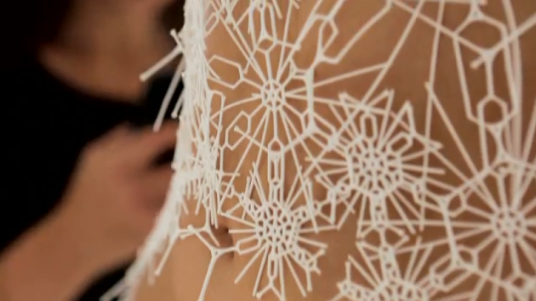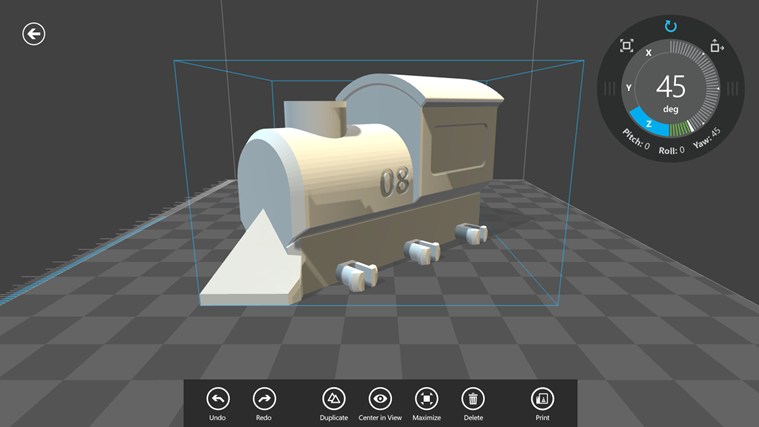
Model Lindsay Ellingson was 3D scanned to ensure a perfect fit for her 3D printed winter themed costume. Courtesy of Shapeways.
November 20, 2013
In the course of my diligent efforts to keep you good people up to date on the state of additive manufacturing (AM), I come across many interesting news items. I’ll gather them up every so often and present them in a Rapid Ready Roundup (like this one). You can find the last Roundup here.
We’ll start today’s Roundup with some AM news from Microsoft. The tech giant has shown a fair amount of interest in AM, first with its Windows 8.1 support for 3D printers and now by releasing a simple, free app named 3D Builder. Rather than offering another 3D design program, 3D Builder acts like a library of printable objects that can be viewed, duplicated, and scaled to fit a user’s requirements.

From the Windows Experience blog:
We’re entering an exciting new era in which everyone will be able to create and print three dimensional objects. Just imagine being able to print a spare part for a household appliance, or creating your own jewelry line of custom 3D-printed earrings. With Windows 8.1 and the 3D Builder app, all of that is now possible. 3D printers are already on the market and partners like 3D Systems, Autodesk, Dassault Systemes, MakerBot, netfabb, Materialise, Stratasys, Tiertime (PP3DP), and many others are making 3D printing a reality for the masses.
Moving on, Michigan Technological University professor Joshua Pearce has written a book about building an open source lab with the assistance of AM. Titled Open-Source Lab: How to Build Your Own Hardware and Reduce Research Costs, the book outlines Pearce’s quest to produce his own laboratory equipment using a 3D printer at a fraction of the usual cost. For now at least, the book can be viewed for free, though availability will change over time.
Saving time and money aren’t the only advantages to building your own lab equipment, according to Pearce.
Lower cost and less-time investment are actually only secondary benefits of using open-source hardware in your lab. The main advantages of the ‘open-source way’ in science is customization and control. Rather than buy what is on the shelf or available from vendors online, you can create scientific instruments that meet your exact needs and specifications. This really is priceless. The ability to customize research tools is particularly helpful to those on the bleeding edge of science, which need custom, never-seen-before equipment to make the next great discovery.

Next up, DMG Mori has announced it is developing a hybrid production system that incorporates both laser metal deposition and 5-axis CNC milling. The system will use a 2-kW diode laser head located in the machine’s spindle with an HSK interface. Parts built up through AM will then be milled during the manufacturing process to produce parts with (in theory) the best aspects of AM and traditional manufacturing in one. DMG Mori claims a build rate of 3.5 kg/hour, which is quicker than AM built parts alone.
Finally for today, a quick peek at fashion. Victoria’s Secret, Swarovski, and Shapeways joined forces to produce a unique outfit for model Lindsay Ellingson. For the latest Victoria’s Secret show, Ellingson sparkled in a snow-themed costume complete with halo and wings in the Victoria’s Secret Angels tradition.

Holiday shoppers shouldn’t expect to find a clone of Ellingson’s costume in the Victoria’s Secret catalog, however. The frame of snowflakes, wings and halo were all built using one of Shapeway’s 3D printers. Swarovski then added a heaping helping of crystals to give Ellingson her sparkle. While I’m not sure how comfortable it was to wear, the outfit does seem to prove that every industry can profit from AM.
Below you’ll find a video overview of the London 3D Printshow.
Sources: Microsoft,
Subscribe to our FREE magazine, FREE email newsletters or both!
About the Author
John NewmanJohn Newman is a Digital Engineering contributor who focuses on 3D printing. Contact him via [email protected] and read his posts on Rapid Ready Technology.
Follow DE





